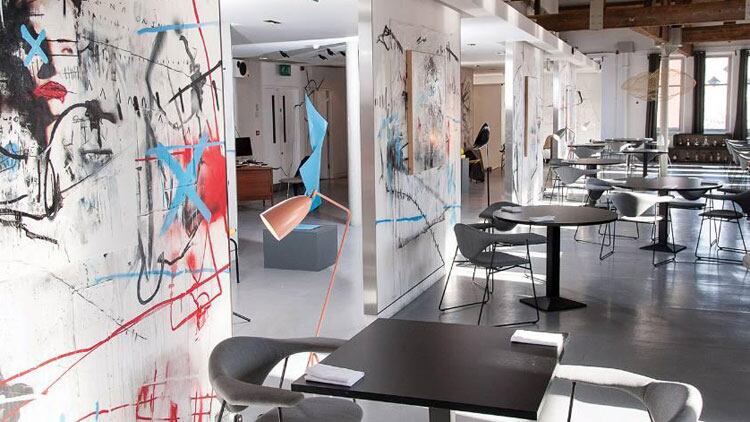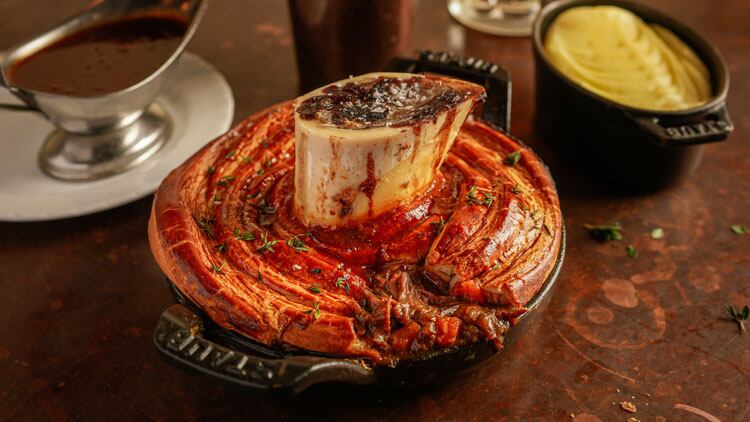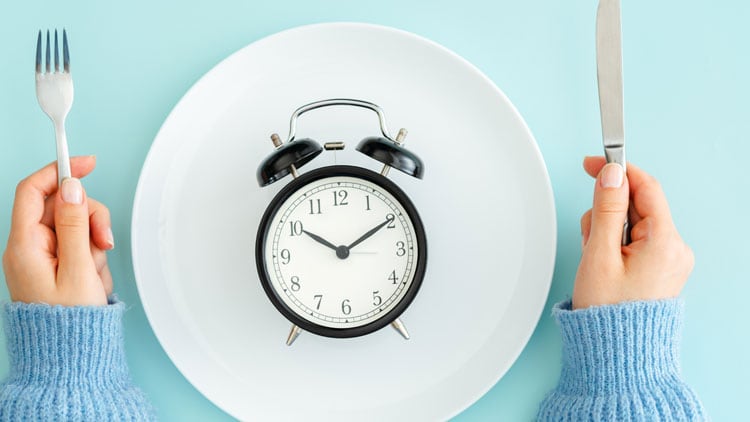On the face of it, Michael O’Hare’s renowned Leeds restaurant is one of the least likely venues to introduce a short, sharp four-course lunch menu. Known for serving a procession of 14 high-impact courses, to dine at The Man Behind the Curtain (TMBTC) is to embark on a culinary journey, one that requires time and a touch of gastronomic stamina. No one expects to pop in and out of this experimental and singular Michelin starred restaurant - where dish names include Sex Wax, Macarons ‘Damien Hirst’, and Dali to Delhi - within an hour.
And yet now they can, thanks to the introduction of a ‘menu rapide’. For significantly less than the £165 O’Hare charges for a Saturday dinner, diners can choose from a four-course menu at lunch for only £40 and a six-course dinner menu priced at just £60.
While it’s not unusual for restaurants to offer cheaper, set lunch menus, it is an unconventional approach for a restaurant such as this. So why the move?
The simple answer, says O’Hare, is that it was a reaction to a slump in bookings restaurants across the country are experiencing, thanks largely to a forced rise in restaurant prices twinned with a cut in diners’ discretionary income as high inflation starts to bite.
“We had seen a decrease in bookings, and you can take that personally and think ‘shit what am I doing wrong?’ or think maybe something else is happening. We’re eight years old now, I’m not really a new chef anymore, so maybe we need to do this to stay relevant?,” says the chef.
“And then I thought, ‘that’s bollocks’. When you speak to other chefs, the honest ones will tell you they are also in the shit and that Saturday nights aren’t full.”
The straw that broke the camel’s back in O’Hare’s case was when he released the next set of reservation dates at the restaurant, a day which traditionally elicits a large number of bookings that are made via the pre-pay reservation system Tock.
“We announce our bookings at the start of the month when everyone has been paid, and there’s usually a rush of advanced bookings,” he says. “But this time we didn’t take a single booking until 4pm and the amount we did take was the same as the day before. That was the first time in my life that that has ever happened.”

A wider trend
The Man Behind the Curtain is not the only restaurant looking to encourage people in at lunchtime with a streamlined menu. This week, steakhouse group Hawksmoor is introducing what it says is a ‘quicker, lighter, and a little more wallet-friendly’ lunch menu, designed for people ‘with somewhere to be at half two or nowhere to be until half five’.
Sitting alongside the full à la carte menu and its express menu, the new lunch menu will be available in all of its restaurants Monday to Saturday with six new dishes to choose from. These include steak and bone marrow pie; a vegetarian winslade wellington; a steak sandwich; and Brixham calamari. Other options include steak frites and a steak salad.
Late last year Sven-Hanson Britt's Nine Elms restaurant Oxeye took a similar route to that of TMBTC with the launch of an obento-style take on its tasting menu. Created as an express lunch option, the obento tray features dishes such as smoked potato sourdough with cultured butter; ginger broth, crisp enoki mushroom, bergamot marinated daikon; white asparagus salad and smoked pollock roe; Mangalitza shoulder poached with chives and pickled shishito; and a choice of either roasted black bream with pumpkin and wild garlic or grilled duck leg, tropea onion and swede.
Those looking to add extras to their meal, ‘to make it a little more grand’, as the restaurant says, can, with additions that include Reblochon on malted buckwheat toast with pickled chilli; Cornish octopus grilled over charcoal with kampot pepper; black mandarin and tonka madeleines; and Yorkshire rhubarb with Balinese vanilla mousse and spelt bran praline, priced between £4 and £25.
“I really believe in what we do. We offer something unique, but we are operating at the niche end of the hospitality scene, not everybody is going to want to come and spend £250 every night," says Britt. “There’s lots of different types of food that we love so my thinking behind it was offer a lunch menu of the kind of food we want to eat if we were going to lunch."
At £35, the obento menu is significantly cheaper than Oxeye’s £90 carte blanche offer or its £125, two-and-a-half hour evening tasting menu, allowing diners a much cheaper - and shorter - entry level into the restaurant. "We have created something relatively accessible in terms of speed," according to Britt, who says diners can be in and out in 45 minutes if they tell the restaurant in advance.
Moreover, the lunch menu is proving to be an accessible gateway to Oxeye's more involved dinner offer. "It is still same quality, the same ingredients and style in terms of cooking. We are trying to get more people through the door. We give people a tiny snapshot of what we do and if they love it they often come back for dinner. That's the whole point of it really."
Such has been its success that Britt says he is in discussions about opening for lunch on more days of the week. "We have to be clever about what we are using and how it impacts on the kitchen because spend per head is smaller and we haven’t got the ability to double up staff, but it is a consideration for us."

The expense of eating out
So, what’s driving this trend? O’Hare believes with restaurants such as his it’s the knock-on effect of price rises – and not just for restaurant-related items.
“The main issue isn’t just the increase in price in restaurants. We have gone up in price but not in a way that will break anyone’s bank account,” says O’Hare, whose menus at TMBTC have risen by £40 over the past four years. “With the pursuit of trying to stay relevant our cost of ingredients has gone up naturally. We are using more expensive produce now than we ever were and there is a demand for that.”
Instead, he regards the rising costs of making a trip to a Michelin starred restaurant like his as becoming more prohibitive for people.
“Around 30% of our clientele is from Leeds and west Yorkshire and then everyone else travels to us. If you’re eating in a Michelin starred restaurant, then you’re travelling first class on the train – for two people that’s around £400 return. Then there’s a hotel room, which is another £300. Our average spend is £300 a head so you’re up to £1,300. We don’t get £1,300 we only take £300 per person, but for £1,300 you can go to Tenerife.
“It pains me as a chef to say this because it’s my product but it’s not worth it. It’s a perishable product. You could say that that the memories live with you forever but some of the best meals of my life I can’t remember what I had.”
The meu rapide, then, is a way of attracting a new, more local crowd, one that doesn’t need to spend on travel and accommodation. It’s about broadening the appeal of a restaurant that, hitherto, was quite narrow in its appeal.
"We have a responsibility for our livelihoods
but also for fine dining. If it’s going to continue
to exist, it needs to have people eating it”
“We definitely need to appeal to more people,” O’Hare admits. “Everyone in Leeds knows the restaurant but the percentage of people who have eaten there isn’t relative to that amount of people. If you know about us and are interested in us but haven’t been the reason must be financial. We have a responsibility for our livelihoods but also for fine dining. If it’s going to continue to exist, it needs to have people eating it.”
That said, the decision behind the menu was not one that was taken lightly. “Because we’re a Michelin star restaurant I felt massive pressure to not devalue the product,” he admits. “You can stick to your guns and say, ‘fuck this we’re a 14-course tasting menu restaurant’ but in reality, we have to adapt or we close.”
It’s not the first time that O’Hare has taken such measures. Last year he introduced a Black Friday sale that utilised dynamic pricing, with the price of meals adjusted depending on the time of day and the day if the week. The result was a booked-out restaurant.
“It was looking like our shittest ever December and a particularly depressing January,” O’Hare recalls. “Going into sale sounds bad but Black Friday gave us a social excuse to do it. We were full December and January. Granted, we didn’t take what we would normally take on full price, but the response was absolutely unreal.”
The appeal of a menu rapide is that from a guest’s perspective it doesn’t look cheap. It has further appeal from a delivery perspective, too. With a 14-course menu there are inevitably dishes that can’t be taken off because people expect them when they dine, he says.
“We have dishes that have been on the menu for maybe three years that are close to perfect as we can get them. Taking them off and putting something else on for the hell of it is a huge risk.” However, with the new menus dishes can be developed and changed frequently giving customers who may visit the restaurant twice a year at most a reason to come more frequently.
If successful, the menu rapide could potentially even change the model of the restaurant, O’Hare says. “We never relay tables, but maybe the future is doing twice as many people at half the price. People are still eating, the world’s not getting thinner.
“After Covid people have more free time, they work more flexibly and so lunches should flourish in theory. If it’s popular we might look to switch to a slightly different format in the next year or so.”


